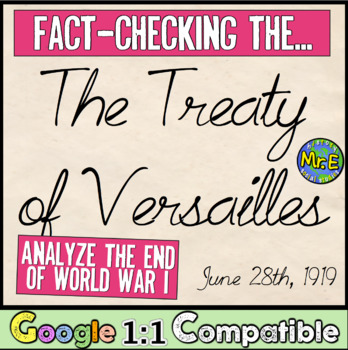Treaty of Versailles and Ending of World War 1 | Student Fact-Checking Activity
- Zip
What educators are saying
Description
In this engaging primary source analysis activity on the Treaty of Versailles that ended World War I, students fact-check a variety of statements about the terms issued down in the Treaty of Versailles to end World War One (known as the war to end all wars)!
Students can work individually, in groups, or complete as a homework assignment to tackle this assignment! Students verify statements, then find the proof to back their statements!
A Google 1:1 compatible version is included in this product! Use in either a traditional setting or in the 1:1 environment!
This activity is included in the much larger World War I Bundle! Scramble for Africa, Causes, Trench Warfare, & Versailles!
----
Be sure to follow the History with Mr E Facebook page, and don't forget to signup for the Social Studies Newsletter to receive information on flash sales, product releases, and classroom tips!
----





